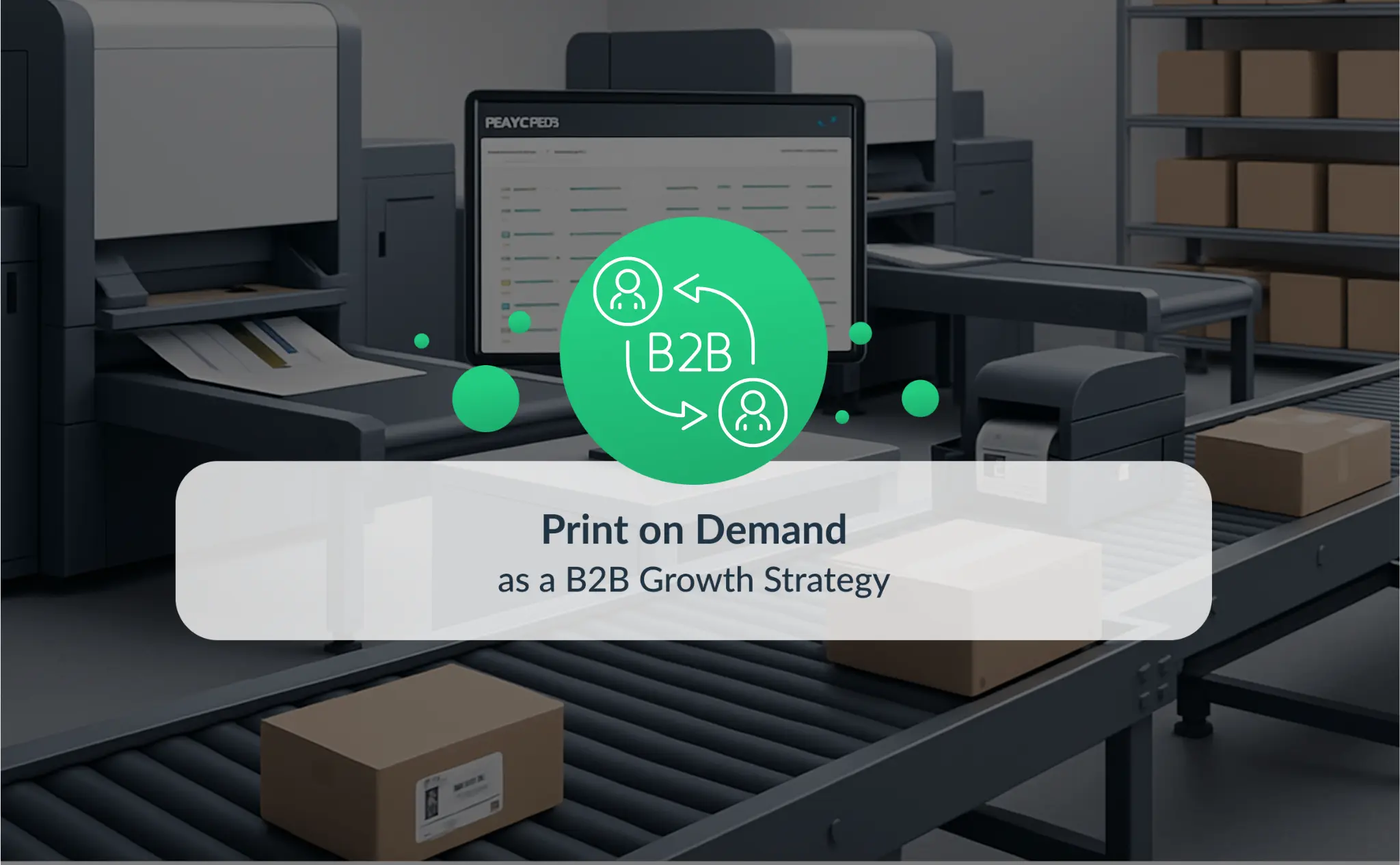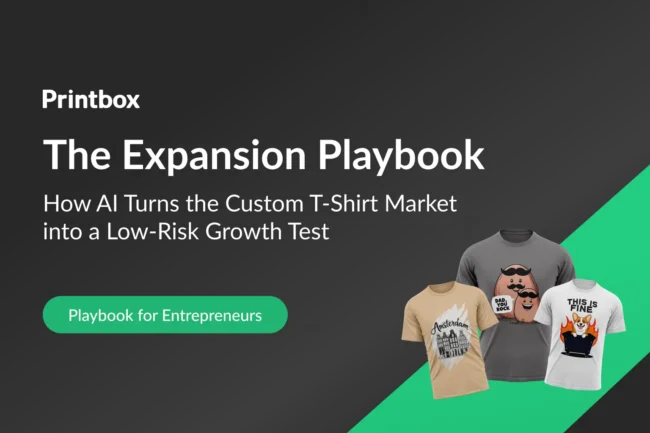Margin pressure and manual workflows: two challenges that never seem to leave e-commerce teams working in personalized photo products. Whether you’re managing hundreds of SKUs or juggling seasonal campaigns, the balance between offering personalized experiences and maintaining operational efficiency often feels impossibly tight. That tension is pushing more B2B businesses to rethink static fulfillment models—and many are arriving at the same question: what is print on demand, and how can we make it work for us?
This isn’t just a consumer trend. For B2B teams, print on demand is emerging as a smart operational strategy that supports client engagement, accelerates time-to-market, and cuts the guesswork out of inventory forecasting. When integrated with SaaS workflows and CRM tools, print on demand becomes more than just a fulfillment method—it becomes an engine for scalable, memorable personalization.
What is Print on Demand?
At its core, print on demand is a manufacturing and fulfillment model where products are printed only after an order is placed. While B2C brands have used this to sell custom T-shirts and mugs without stocking inventory, the model’s real power for B2B lies in flexibility and precision personalization.

In a B2B environment, print on demand enables companies to create tailored product experiences—like customized onboarding boxes, branded event kits, or white-labeled photo books—without locking into minimum order quantities or warehouse space. So when we ask what is print on demand, the answer isn’t just a method of fulfillment—it’s a blueprint for operational agility.
How is this possible? Print on demand companies act as both manufacturers and logistics partners, allowing businesses to plug in their product designs and APIs, and outsource everything from printing and packaging to global delivery. This model has mass appeal, and for good reason: it replaces batch production with real-time, responsive printing.
A growing number of B2B photo product retailers are leveraging print on demand as a way to reduce operational rigidity. By moving from pre-printed batch inventory to just-in-time manufacturing, teams gain the flexibility to test new templates, runs, or client-specific variations without overcommitting resources. It’s a shift that combines creative freedom with financial prudence—especially when tied into customer segmentation logic from CRMs or campaign tools.
Why Choose Print on Demand?
There’s a reason that print on demand is catching traction not just with startups, but with established B2B players looking to sharpen their edge. The benefits go beyond operational convenience—they touch the heart of differentiation, customer loyalty, and brand storytelling.
- No upfront inventory costs: Without the need to bulk-produce and warehouse items, cash flow remains fluid and risk is dramatically reduced.
- Scalable personalization: B2B campaigns—think partner gifts or client welcome kits—can be customized down to the individual level without slowing distribution.
- Agility and testing: New concepts can be launched with minimal setup, helping your team experiment, iterate, and respond to trends faster.
For account-based marketing or reseller enablement programs, being able to personalize kits or collateral at scale solves a huge logistical challenge. Need 200 client-specific photo books next week? With print on demand, that’s a process—not a crisis.
Among B2B marketers, there’s increasing interest in using print on demand to support customer lifecycle moments—milestones like renewals, product upgrades, or quarterly business reviews. Personalized photo-based gifts or collateral not only make these touchpoints more memorable but also reinforce brand identity in a tangible, lasting format. The ability to automate such triggers via integration with CRM platforms is changing how businesses think about gifting and retention strategies.
This aligns with broader changes across the e-commerce and personalization space. As noted in AI: The Future of Personalized Printing, there’s a rising expectation for hyper-relevant moments powered by automation and design intelligence—a trend that print on demand is perfectly positioned to serve.
How Does Print on Demand Work?
The typical print on demand workflow starts with a customer order and ends with a delivered product—simple in theory, but powerful in its flexible execution. Here’s a high-level breakdown:
- Product selection and design: The business (or end customer through an online tool) selects a template and customizes it.
- Order triggers: Once an order is placed, it automatically routes to a print on demand provider’s system.
- Production queue: The product is printed, often using digital printing techniques optimized for one-off or small-batch runs.
- Fulfillment and shipping: The item is packaged and shipped directly to the customer, often under the brand’s own label.

This entire flow is ripe for SaaS integration. For example, sales reps using CRMs like HubSpot or Salesforce can trigger personalized merchandise after a deal closes. Marketing teams might link print on demand services to campaign platforms to send one-off branded photo kits during nurture workflows. When print on demand services are integrated at this level, customization doesn’t rely on manual ops—it flows from system logic.
The market is seeing a rapid acceleration in demand for print on demand platforms that offer out-of-the-box API access and support for tools like Shopify, Salesforce, or custom-built storefronts. Printbox, for instance, delivers end-to-end tooling that connects design editors, ordering systems, and backend production workflows—enabling B2B clients to automate at scale without sacrificing creative control. This is where serious operational efficiency meets high-impact personalization.
If you’re curious about which technologies enable this seamless flow from click to shipment, our breakdown of Different Printing Methods for the Web-to-Print Industry explores some key players and use cases.
Common Products in Print on Demand
So what kinds of items work best with print on demand in a B2B context? A lot more than just mugs and wall art. Let’s take a closer look:
- Print on demand shirts: These remain a reliable staple for events and company swag—especially when tailored for department-specific messaging or campaign branding.
- Photo books: Popular for client recaps, internal storytelling, and commemorative gifts.
- Branded packaging kits: Ideal for onboarding new clients or surprising long-term partners with milestone boxes.
- Desk items and small office goods: Calendars, notepads, mousepads—low-cost, highly customizable, and functional in B2B environments.
The goal isn’t mass-producing novelty merch—it’s delivering items that support communication, enhance engagement, or simply say “we see you” in meaningful moments.
This is also where B2B print on demand diverges from other on-demand fulfillment models. For a full comparison, see our article on Print on Demand vs. Dropshipping, which outlines key differences in margins, brand control, and personalization capacity.
Pros and Cons of Print on Demand
No strategy is without tradeoffs, and while print on demand offers distinct advantages, it requires thoughtful implementation to reach its full potential. Let’s unpack what works—and what to watch for.
Pros:
- Low financial risk: Since goods aren’t produced until ordered, you avoid sunk costs from unsold stock.
- Speed and scale: You can produce personalized items across global markets without building a physical presence.
- Automation potential: Integrations with e-commerce, CRM, or ERP systems streamline the entire process.
Cons:
- Margin variation: Smaller order quantities can carry higher unit costs. Choosing the right provider—and negotiating SLAs—matters.
- Quality consistency: Without in-house control, quality issues can affect customer satisfaction. Review samples, test providers.
- Regulatory compliance: For industries with strict data handling rules (e.g., healthcare, finance), ensure your POD partner meets relevant standards.
One of the key trends emerging in the B2B print on demand space is a deepening focus on geographic fulfillment strategies. Rather than relying on a single production hub, more companies are choosing partners with distributed networks—producing closer to the end customer to reduce costs and environmental impact. This strategy not only improves delivery speed but also strengthens service-level reliability in key markets.
Naturally, the question arises: is print on demand profitable? The answer depends on execution. When built into automated customer journeys and supported by smart pricing, print on demand can deliver strong ROI—especially in relationship-driven fields where retention is gold.
Just be sure you evaluate print on demand companies not only for price, but also for their ability to scale with your brand. Strong reporting, SLA clarity, and tech compatibility should be part of the procurement checklist alongside product quality.
Ready to Make Print on Demand Work for You?
Whether you’re delivering client recognition kits, streamlining internal merch, or building out an e-commerce catalog of print on demand products—success is in the setup. The right strategy, platform, and integration make all the difference.
Want to see it in action? Book a Printbox demo to explore how personalized photo products can flow from your CRM to customer doorstep in days, not weeks. Have questions about integrating POD into your B2B systems? Contact the Printbox team—we’d love to help you explore what’s possible.
What is print on demand in a B2B context?
Print on demand for B2B is a fulfillment model where products are only manufactured after an order is placed. It enables teams to create personalized, just-in-time items like onboarding kits or client gifts without holding inventory or managing complex logistics.
How does print on demand improve operational efficiency?
Print on demand reduces manual workflows by automating production and fulfillment, often through integrations with CRMs or marketing platforms. This cuts inventory guesswork and speeds up personalized campaigns at scale.
What are the benefits of using print on demand for B2B marketing?
Print on demand supports scalable personalization, faster time-to-market, and lower financial risk by eliminating upfront inventory. It enhances campaigns with customized collateral tailored to individual clients or lifecycle milestones.
Which products work best for B2B print on demand?
Popular B2B print on demand products include branded photo books, onboarding kits, customized office items, and personalized apparel. These items add value in key customer touchpoints and internal engagement efforts.
Can print on demand integrate with our CRM or e-commerce tools?
Yes, modern print on demand platforms often offer API access and native integrations with CRMs like Salesforce or tools like Shopify. This allows teams to trigger product sends automatically based on customer actions or campaigns.
Is print on demand profitable for business use?
When implemented with the right provider and aligned with campaign goals, print on demand can deliver strong ROI. It reduces waste, enhances customer experiences, and supports retention-driven strategies cost-effectively.
What’s the difference between print on demand and dropshipping in B2B?
While both models reduce inventory risk, POD focuses on custom, made-to-order products—often with brand personalization—whereas dropshipping usually involves pre-made items shipped from a third-party warehouse. POD is better suited for personalization and branded customer touchpoints.
What should I look for in a B2B print on demand partner?
Beyond product quality, evaluate:
-
API and integration support
-
SLA terms and geographic fulfillment options
-
Data compliance (especially in regulated industries)
-
Reporting, scalability, and tech compatibility
Choose a partner who fits into your stack, not one you need to build around.




